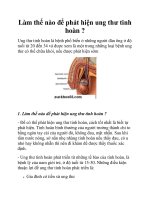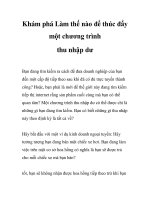Software testing: Dynamic testing
Bạn đang xem bản rút gọn của tài liệu. Xem và tải ngay bản đầy đủ của tài liệu tại đây (2.03 MB, 66 trang )
Presented by
Ngo Thi Hoan
Contents
What is a testing technique?
How to choose that which testing technique is best?
Black box test techniques
White box test techniques
Error Guessing
What is a testing technique?
a procedure for selecting or designing tests
based on a structural or functional model of the software
successful at finding faults
'best' practice
a way of deriving good test cases
a way of objectively measuring a test effort
Testing should be rigorous, thorough and systematic
How to choose that which testing
technique is best?
This is the wrong question!
Each technique is good in its own way in finding out the
certain kind of defect, and not as good for finding out the
other kind of defects
Ex: Structure-based technique – find out the
defect/problem in the code. Specification-based
techniques find out missing specification of code.
Each individual technique is aimed at particular types of
defect. For example, state transition testing is unlikely to find
boundary defects.
Three types of systematic technique
Static (non-execution)
• examination of documentation,
source code listings, etc.
Functional (Black Box)
• based on behaviour /
functionality of software
Structural (White Box)
• based on structure
of software
Some test techniques
Dynamic
Static
etc.
Reviews
Inspection
Walkthroughs
Structural
Desk-checking
Symbolic
Execution
Non-functional
Functional
etc.
etc.
Control
Flow
Data
Flow
etc.
Behavioural
Static Analysis
Performance
etc.
Statement
Branch/Decision
Definition
-Use
Branch Condition
Equivalence
Partitioning
Usability
Arcs
LCSAJ
Branch Condition
Combination
Boundary
Value Analysis
Cause-Effect Graphing
Random
State Transition
Black box versus white box?
Black box appropriate
at all levels but
dominates higher
levels of testing
White box used
predominately
at lower levels.
Acceptance
System
Integration
Component
Black box versus white box?
Black- box testing
Black Box Testing is testing technique having
no knowledge of the internal
functionality/structure of the system
Black-box Testing focuses on testing the
function of the program or application against
its specification
Determines whether combinations of inputs
and operations produce expected results
It is also called as behavioral testing and
closed box testing.
Black-Box Testing Techniques
Techniques defined in BS 7925-2
Equivalence partitioning
Boundary value analysis
Decision table testing
Cause-effect graphing
State transition testing
Equivalence partitioning (EP)
Divide (partition) the inputs, outputs, etc. into areas which are the same
(equivalent)
Assumption: if one value works, all will work
One from each partition better than all from one
Ex: Login page, user field can accept 1 to 100 character:
invalid
valid
0
1
100
invalid
101
Equivalence partitioning (EP)
Conditions
Valid Equivalence class
1) 1<= VP <= 100
Invalid Equivalence Class
2) IP<1
3) IP>100
4) null
Result
Test cases
5. True
1) 1,5
6. False
2) 2,6
7. Error message
3) 3,6
4) 4,7
Boundary value analysis (BVA)
This technique consists of developing test cases and data that focus on the
input and output boundaries of a given function
faults tend to lurk near boundaries
good place to look for faults
test values on both sides of boundaries
Ex: Login page: user field accepts 6 to 55 character.
Test cases: Invalid test case (5, 56, null), Valid test case (6, 55, 7, 54).
invalid
valid
5
6
invalid
55
56
Example: Loan application
Customer Name
2-64 chars.
Account number
6 digits, 1st
non-zero
Loan amount requested
Term of loan
Monthly repayment
£500 to £9000
1 to 30 years
Term:
Repayment:
Interest rate:
Total paid back:
Minimum £10
Customer name
Number of characters:
invalid
Valid characters:
Conditions
Customer
name
Valid
Partitions
2 to 64 chars
valid chars
1
2
valid
A-Z
-’ a-z
space
Invalid
Partitions
< 2 chars
> 64 chars
invalid chars
64 65
invalid
Any
other
Valid
Boundaries
2 chars
64 chars
Invalid
Boundaries
1 chars
65 chars
0 chars
Account number
first character:
valid: non-zero
invalid: zero
number of digits:
invalid
Conditions
Account
number
Valid
Partitions
6 digits
1st non-zero
Invalid
Partitions
< 6 digits
> 6 digits
1st digit = 0
non-digit
5
6
7
valid
Valid
Boundaries
100000
999999
invalid
Invalid
Boundaries
5 digits
7 digits
0 digits
Loan amount
499
invalid
Conditions
Loan
amount
Valid
Partitions
500 - 9000
500
9000
valid
Invalid
Partitions
< 500
>9000
0
non-numeric
null
9001
invalid
Valid
Boundaries
500
9000
Invalid
Boundaries
499
9001
Condition template
Conditions
Valid
Partitions
Tag
Customer 2 - 64 chars
valid chars
name
V1
V2
Account
number
6 digits
1st non-zero
V3
V4
Loan
amount
500 - 9000
V5
Invalid
Valid
Tag
Tag
Boundaries
Boundaries
< 2 chars
D1
B1 1 char
X1 2 chars
> 64 chars
D2
B2 65 chars
X2 64 chars
0 chars
invalid char X3
D3
< 6 digits
D4
B3 5 digits
X4 100000
> 6 digits
D5
B4 7 digits
X5 999999
st
0 digits
1 digit = 0 X6
D6
non-digit
X7
< 500
D7
B5 499
X8 500
>9000
D8
B6 9001
X9 9000
0
X10
non-integer X11
null
X12
Invalid
Partitions
Tag
Design test cases
Customer
name
V1
V2
X1
X2
X3
B1
B2
D1
D2
D3
Account
number
V3
V4
X4
X5
X6
X7
B3
B4
D4
D5
D6
Loan
account
V5
X8
X9
X10
X11
X12
B5
B6
D7
D8
Valid test
cases
v1,v3,v5
v1,v4,v5
v1,b3,b5
v1,b5,b6
v2,v3,v5
....
Invalid test
cases
X1, X4, X8
X1,X5,X9
X1,X6,X10
....
....
...
Design test cases
Test
Case
Description
Expected Outcome
New Tags
Covered
1
Name:
Acc no:
Loan:
Term:
John Smith
123456
2500
3 years
Term:
Repayment:
Interest rate:
Total paid:
3 years
79.86
10%
2874.96
V1, V2,
V3, V4,
V5 .....
2
Name:
Acc no:
Loan:
Term:
AB
100000
500
1 year
Term:
Repayment:
Interest rate:
Total paid:
1 year
44.80
7.5%
537.60
B1, B3,
B5, .....
Test objectives?
Condition
Valid
Partition
Tag Invalid
Partition
Tag Valid
Boundary
Tag Invalid
Boundary
Tag
For a thorough approach: VP, IP, VB, IB
Under time pressure, depends on your test objective
- minimal user-confidence: VP only?
- maximum fault finding: VB first (plus IB?)
Decision tables
A decision table is a good way to deal with combinations of things.
Sometimes also referred as “Cause-effect” table.
Cause – effect graphing was used to help derive the decision table.
Explore combinations of inputs, situations or events,
it is very easy to overlook specific combinations of input
Start by expressing the input conditions of interest so that they are
either TRUE or FALSE
Example: student access
A university computer system allows students an allocation of
disc space depending on their projects.
If they have used all their allotted space, they are only allowed
restricted access, i.e. to delete files, not to create them. This is
assuming they have logged on with a valid username and
password.
What are the input and output conditions?
List the input and output conditions
• list the ‘input
conditions’ in the first
column of the table
• list the ‘output
conditions’ under the
input conditions
Input Conditions
Valid username
Valid password
Account in credit
Output Conditions
Login accepted
Restricted access









